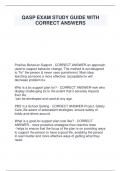QASP EXAM STUDY GUIDE WITH
CORRECT ANSWERS
Positive Behavior Support - CORRECT ANSWER-an approach
used to support behavior change. The method is not designed
to "fix" the person & never uses punishment. Main idea:
teaching someone a more effective/ acceptable bx will
decrease problem bx.
Who is a bx support plan for? - CORRECT ANSWER-indv who
display challenging bx to the extent that it severely impacts
their life.
-can be developed and used at any age.
PBS in a School Setting - CORRECT ANSWER-Proact, Safety
Care, Be aware of antecedant strategies, ensure safety of
kiddo and others around.
What is a good bx support plan look like? - CORRECT
ANSWER-- more proactive strategies than reactive ones
- helps to ensure that the focus of the plan is on providing ways
to support the person to have a good life, enabling the person
to learn better and more effective ways of getting what they
need.
,Proactive Strategies - CORRECT ANSWER-Intended to make
sure the person gets what they need & includes ways to teach
the person appropriate communication & life skills.
Reactive Strategies - CORRECT ANSWER-Designed to keep
the person & those around them safe from harm. They provide
a way to react quickly when person is distressed & more likely
to display challenging behavior.
Functions of Behaviors & Alternatives - CORRECT ANSWER-
Sensory:teach them to ask for desired object/ activity, use
preferred sensory items to create new activities, have sensory
time & structured activity so stimming doesn't take over
Escape:Teach them to say yes/ no, ask for break/ all done,
introduce them to a less preferred activity gradually, change the
way you ask them to do something
Attention: Teach them to tap/ vocalize sign for desired item;
give frequent positive social attn
Tangibles:teach them to ask for object/ activity, Give what they
asked for as soon as appropriate, teach them to get something
themselves, Make sure they are not left too long w/o food/drink/
something meaningful to do.
What is Discrete Trial Training? - CORRECT ANSWER-a
Method of teaching in simplified & structured steps. A skill is
broken down into steps & built up one step at a time. Each
attempt is a "trial".
5 steps of DTT - CORRECT ANSWER-1.Antecedent-sets up
the response (SD, environment)
2.Prompt
3.Response
4. Consequence for Correct Response/ Incorrect response
5. Inter-trial interval
, Pros of DTT - CORRECT ANSWER-Scripted to ensure all trials
are consistent, can increase motivation & learning, numerous
learning opportunities, can be easily individualized, clear
beginning & end to each trial, can minimize failures
Cons of DTT - CORRECT ANSWER-Difficult to generalize,
boring, lacks naturalistic reinforcement, difficulty fading
reinforcement
Purpose of Person Centered Planning - CORRECT ANSWER-
ongoing problem solving process used to help ppl w disabilities
plan for the future:
-To look at the ind a different way
-To assist the focus person in gaining control of their own life
-To increase opportunities for participation in the community
-To recognize individual desires, interests & dreams
-Through team effort, develop a plan to turn dreams into reality.
Who is involved in Person Centered Planning? - CORRECT
ANSWER-The focus person & whoever they would like. Works
best when there is an unbiased facilitator & a person to record
what is shared. Family members, professionals, friends, etc
may be invited.
Steps of Person Centered Planning: Profiling - CORRECT
ANSWER-1. Develop a history for focus person. (Background,
critical events, medical issues, major developments, important
relationships)
2. Description of quality of life for FP. (Comm participation,
comm presence, choices/rights, respect & competence)
3. Personal preferences of FP. (Preferred activities, things they
do not like)
Person Centered Planning Meeting - CORRECT ANSWER-1.
Review the profile. Make comments & observations
2. Review trends/ongoing events in the environment.





